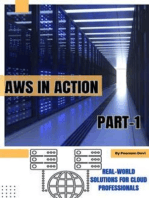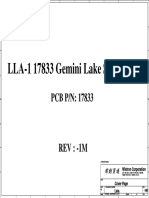Best Practices For Running Oracle Database On Aws 5
Uploaded by
anandduhanBest Practices For Running Oracle Database On Aws 5
Uploaded by
anandduhanAmazon Web Services Best Practices for Running Oracle Database on AWS
Introduction
Amazon Web Services (AWS) provides a comprehensive set of services and tools for
deploying Oracle Database on the reliable and secure AWS Cloud infrastructure. AWS
offers its customers three options for running Oracle Database on AWS:
1. Using Amazon Relational Database Service (Amazon RDS) for Oracle, which is a
managed database service that helps simplify the provisioning and management
of Oracle databases. Amazon RDS for Oracle makes it easy to set up, operate,
and scale a relational database in the cloud by automating installation, disk
provisioning and management, patching, minor version upgrades, failed instance
replacement, as well as backup and recovery tasks. The push-button scaling
feature of Amazon RDS allows you to easily scale the database instance up or
down for better cost management and performance. Amazon RDS for Oracle
offers both Oracle Database Enterprise Edition and Oracle Database Standard
Edition. Amazon RDS for Oracle also comes with a license-included service model,
which allows you to pay per use by the hour.
2. Running a self-managed Oracle Database directly on Amazon Elastic Compute
Cloud (Amazon EC2). This option gives you full control over the setup of the
infrastructure and database environment. Running the database on Amazon EC2
is very similar to running the database on your own server. You have full control
of the Oracle binaries database and have operating system-level access, so you
can run monitoring and management agents and use your choice of tools for data
replication, backup, and restoration. Furthermore, you have the ability to use every
optional module available in Oracle Database. However, this option requires you
to set up, configure, manage, and tune all the components, including Amazon EC2
instances, storage volumes, scalability, networking, and security based on AWS
architecture best practices. In the fully-managed Amazon Relational Database
Service (Amazon RDS) service, this is all taken care of for you.
3. FlashGrid Cluster virtual appliances enable running self-managed Oracle Real
Application Cluster (RAC) and Oracle RAC extended clusters (across different
AZs) on Amazon EC2. With FlashGrid Cluster you also have full control of the
database and have operating system-level access.
Page 1
You might also like
- AWS Certified Cloud Practitioner - Practice Paper 1: AWS Certified Cloud Practitioner, #1From EverandAWS Certified Cloud Practitioner - Practice Paper 1: AWS Certified Cloud Practitioner, #14.5/5 (2)
- Comparison of Oracle Cloud Vs Amazon RDSNo ratings yetComparison of Oracle Cloud Vs Amazon RDS7 pages
- AWS Certified Cloud Practitioner - Practice Paper 4: AWS Certified Cloud Practitioner, #4From EverandAWS Certified Cloud Practitioner - Practice Paper 4: AWS Certified Cloud Practitioner, #4No ratings yet
- DAT325 - Managed Oracle Databases With Amazon RDS New Features and Best PracticesNo ratings yetDAT325 - Managed Oracle Databases With Amazon RDS New Features and Best Practices48 pages
- Best Practices For Running Oracle Database On Aws 12No ratings yetBest Practices For Running Oracle Database On Aws 121 page
- Best Practices For Running Oracle Database On Aws 21No ratings yetBest Practices For Running Oracle Database On Aws 211 page
- RDBMS in The Cloud: Oracle Database On AWS: October 2013100% (1)RDBMS in The Cloud: Oracle Database On AWS: October 201333 pages
- EV_under-the-hood-how-to-run-oracle-databases-on-aws_Mar-2021No ratings yetEV_under-the-hood-how-to-run-oracle-databases-on-aws_Mar-202134 pages
- Mastering Amazon Web Services: Comprehensive Techniques for AWS SuccessFrom EverandMastering Amazon Web Services: Comprehensive Techniques for AWS SuccessNo ratings yet
- AWS Cloud Automation: Harnessing Terraform For AWS Infrastructure As CodeFrom EverandAWS Cloud Automation: Harnessing Terraform For AWS Infrastructure As CodeNo ratings yet
- Mastering the Art of Cloud Computing with AWS: Unraveling the Secrets of Expert-Level ProgrammingFrom EverandMastering the Art of Cloud Computing with AWS: Unraveling the Secrets of Expert-Level ProgrammingNo ratings yet
- Cloud Database Battle: AWS vs. DIY vs. Oracle: By, David FloyerNo ratings yetCloud Database Battle: AWS vs. DIY vs. Oracle: By, David Floyer14 pages
- AWS Certified Cloud Practitioner - Practice Paper 2: AWS Certified Cloud Practitioner, #2From EverandAWS Certified Cloud Practitioner - Practice Paper 2: AWS Certified Cloud Practitioner, #25/5 (2)
- AWS Certified Solutions Architect Associate Exam Insights : Q&A with ExplanationsFrom EverandAWS Certified Solutions Architect Associate Exam Insights : Q&A with ExplanationsNo ratings yet
- AWS in ACTION Part -1: Real-world Solutions for Cloud ProfessionalsFrom EverandAWS in ACTION Part -1: Real-world Solutions for Cloud ProfessionalsNo ratings yet
- Migrating Oracle Database Workloads To Oracle Linux On Aws PDFNo ratings yetMigrating Oracle Database Workloads To Oracle Linux On Aws PDF21 pages
- AWS for Beginners: A Step-by-Step Guide to Cloud ComputingFrom EverandAWS for Beginners: A Step-by-Step Guide to Cloud ComputingNo ratings yet
- AWS CloudFormation Essentials: A Practical Guide to Automating Cloud InfrastructureFrom EverandAWS CloudFormation Essentials: A Practical Guide to Automating Cloud InfrastructureNo ratings yet
- 2 +Handout+-+Deploying+open+source+databases+on+AWSNo ratings yet2 +Handout+-+Deploying+open+source+databases+on+AWS30 pages
- Slides_Migrate_and_modernize_commercial_databases_on_AWSNo ratings yetSlides_Migrate_and_modernize_commercial_databases_on_AWS36 pages
- Step by Step: Fault-tolerant, Scalable, Secure AWS Web StackFrom EverandStep by Step: Fault-tolerant, Scalable, Secure AWS Web StackNo ratings yet
- Running Production PostgreSQL Databases On Amazon RDS For PostgreSQLNo ratings yetRunning Production PostgreSQL Databases On Amazon RDS For PostgreSQL42 pages
- What Is Amazon Relational Database Service (Amazon RDS)No ratings yetWhat Is Amazon Relational Database Service (Amazon RDS)8 pages
- AWS Certified Cloud Practitioner - Practice Paper 3: AWS Certified Cloud Practitioner, #3From EverandAWS Certified Cloud Practitioner - Practice Paper 3: AWS Certified Cloud Practitioner, #35/5 (1)
- Amazon RDS For Oracle Advanced FeaturesNo ratings yetAmazon RDS For Oracle Advanced Features35 pages
- AWS in Action Part -2: Real-world Solutions for Cloud ProfessionalsFrom EverandAWS in Action Part -2: Real-world Solutions for Cloud ProfessionalsNo ratings yet
- Configuring Amazon Rds As Peoplesoft Database 33No ratings yetConfiguring Amazon Rds As Peoplesoft Database 331 page
- Configuring Amazon Rds As Peoplesoft Database 39No ratings yetConfiguring Amazon Rds As Peoplesoft Database 391 page
- Best Practices For Running Oracle Database On Aws 17No ratings yetBest Practices For Running Oracle Database On Aws 171 page
- Best Practices For Running Oracle Database On Aws 1No ratings yetBest Practices For Running Oracle Database On Aws 11 page
- No Due Certificate - No Dues Certificate Management SystemNo ratings yetNo Due Certificate - No Dues Certificate Management System1 page
- DECLARATION-cum-Supplier Selection Form: WWW - Hareda.gov - in MSENo ratings yetDECLARATION-cum-Supplier Selection Form: WWW - Hareda.gov - in MSE1 page
- Standard Sectional Dimension of H-Welded Steel: and Its Sectional Area, Unit Weight and Sectional CharacteristicNo ratings yetStandard Sectional Dimension of H-Welded Steel: and Its Sectional Area, Unit Weight and Sectional Characteristic2 pages
- (Bca) Back, Lowerupperext Trans CombinedNo ratings yet(Bca) Back, Lowerupperext Trans Combined50 pages
- A Physically Transient Form of Silicon ElectronicsNo ratings yetA Physically Transient Form of Silicon Electronics6 pages
- Healing Your Eyes with Chinese Medicine Acupuncture Acupressure Chinese Herbs Andy Rosenfarb all chapter instant download100% (2)Healing Your Eyes with Chinese Medicine Acupuncture Acupressure Chinese Herbs Andy Rosenfarb all chapter instant download65 pages
- Advances in Parasitology, Volume 115 Russell Stothard All Chapter Instant DownloadNo ratings yetAdvances in Parasitology, Volume 115 Russell Stothard All Chapter Instant Download57 pages
- Analyzing Arguments: Toulmin'S Analysis of ArgumentNo ratings yetAnalyzing Arguments: Toulmin'S Analysis of Argument10 pages
































































































